
table of contents
- Sowing cat grass: timing
- Location
- Sowing: Instructions
- to water
- Fertilize
- Repot
- Cut
- Overwinter
- frequently asked Questions
Regardless of whether you like the look of Cyperus zumula or want to inspire your house tiger, planting cat grass is not difficult. In this article you will find all the information about sowing and care.
In a nutshell
- Cat grass can be sown all year round
- germinates after about 2 weeks
- undemanding to the care
- Cutting measures only slightly necessary
- must be repotted regularly
Sowing cat grass: timing
Before you plant the cat grass, you need to know the right time to sow it. The best: Cyperus zumula, as a classic cat grass, only depends on a sufficiently high temperature and for this reason can be sown all year round. This is particularly effective if you decide at short notice to provide your cats with some nibbling fun.
Location
Another point to consider before planting cat grass is the correct location. You should prepare this so that you can place the growing containers directly. This way you will speed up germination. Another advantage of having the right location is the fact that you don't have to choose a new spot for further cultivation. Both the seedlings and the adult specimens prefer the following location characteristics:
- Light requirement: bright, shady
- avoid direct midday sun
- warm (18 ° C to 25 ° C)
- Window sills are ideal
- alternatively use winter gardens or bright corridors
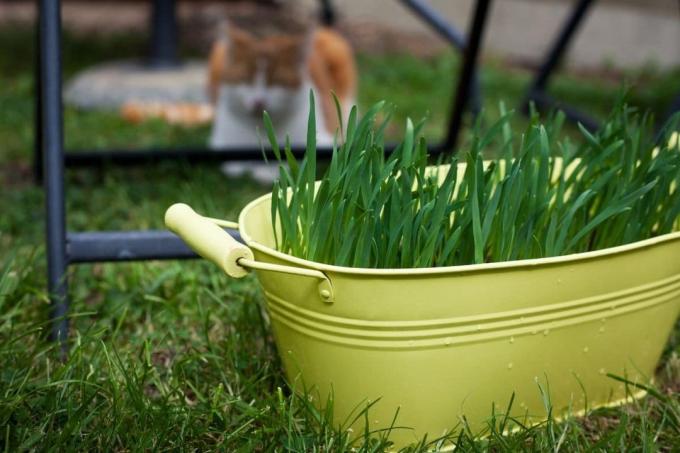
Note: Adult cat grasses can easily be kept on the balcony or in the garden over the summer. Fresh air and sunshine have a positive effect on the vitality of the sour grass family (Cyperaceae).
Sowing: Instructions
Sowing cat grass is not difficult. In order to plant cat grass, in addition to the selected location, the substrate used is particularly important. In order for the seeds to germinate effectively, the following substrates are recommended:
- Potting soil
- Herb soil
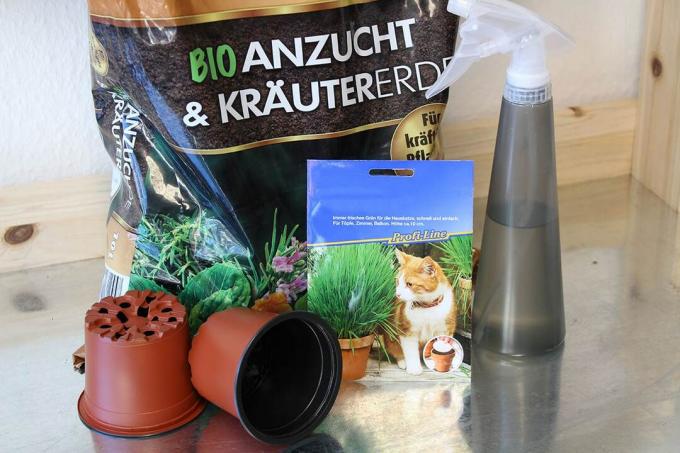
Choose either small seed pots or seed trays for sowing. Alternatively, you can rely on a mini greenhouse if you have one available. You don't need anything else for cultivation. Once you have the right vessel, follow these instructions which will walk you through the process step by step:
- Soak seeds before sowing
- 12 hours in room warm water
- Fill the growing vessels with substrate
- Strain seeds
- distribute on growing medium
- Lightly press
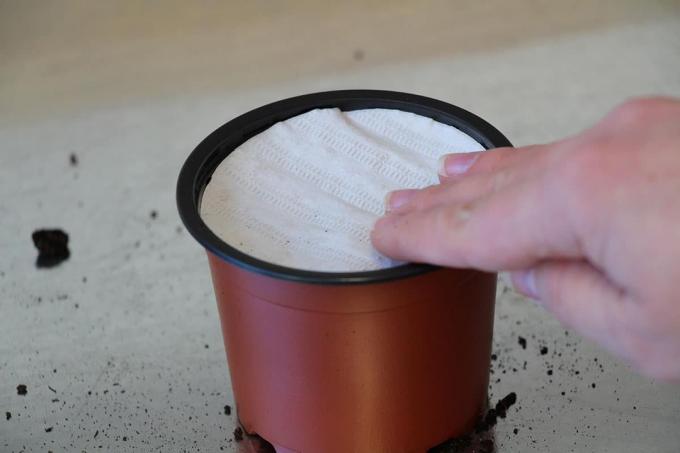
- Spread a thin layer of soil over the seeds
- moisten well
- Use water with little lime
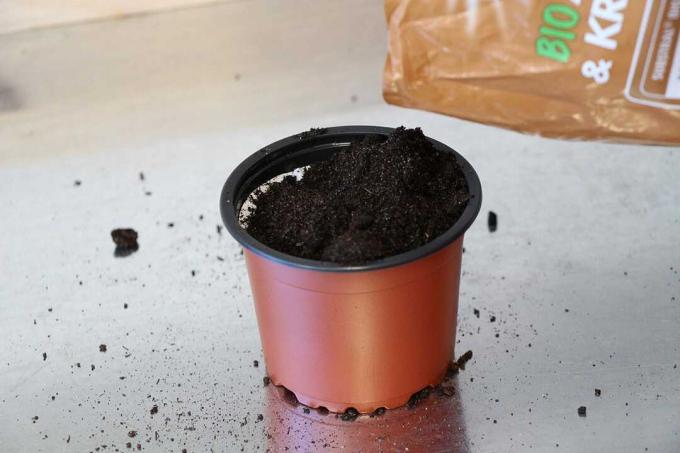
- place at the selected spot
- cover with foil or close mini greenhouse
- Germination time: 12 to 14 days
- Check substrate for moisture daily
- spray with water if necessary

- remove foil after germination
- then follow care measures

to water
Watering is one of the most important things to consider when caring for cat grass. The plants prefer a lot of moisture and should therefore never dry out. A lack of water can be recognized by the brown discolored tips of the stalks. In this case, you should water immediately so that the growths do not die. The marsh plant has no real problem with waterlogging. The following will help you water cat grass properly:
- water several times during the week
- Always keep the soil slightly moist
- Use water with little lime
- e.g. filtered or stale water
- alternatively, fill the coaster with water
- top up regularly

Tip: To optimize the vitality of the grasses, you should spray the plants regularly with water to improve the humidity. This is especially recommended over the winter period, when dry heating air puts the cat grass under pressure.
Fertilize
If you are growing cat grass for your cats, there is no need to fertilize. Additional fertilization measures are only necessary if you are keeping Cyperus zumula as a houseplant. Then do the following:
- Time: spring to autumn
- every 2 weeks
- every 5 to 6 weeks in winter
- Use green plant or herb fertilizer
- Administer exclusively via irrigation water
Repot
Cat grass is not repotted after planting. This is only necessary after a period of one to two years when it has become too big for the bucket. You can orientate yourself on the top layer of the earth. When the roots are completely rooted, it is time for a new container and fresh substrate. The following is recommended as a substrate for the adult specimens:
- sterilized garden soil
- Mix in quartz sand for structure
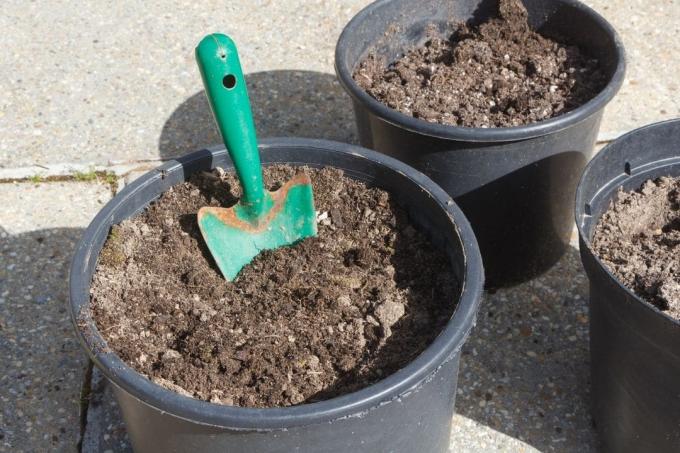
Prepare a pot that is about two inches larger in diameter than the previous one. It should have drain holes and a coaster. Then proceed as follows:
- Remove the cat grass from the pot
- Check roots
- remove dead, dried up or putrid
- fill the new pot with fresh substrate
- Insert the plant
- Fill in the remaining substrate
- Lightly press
- moisten well
Note: Another sign of repotting, which you can use for orientation, are stalks that are brown in color with ideal care measures. A lack of space leads to more and more stalks turning brown.
Cut
Whether or not you have to cut the cat grass after planting depends on the usage. If your cat is a fan of the grasses, you don't need to reach for scissors yourself. Since the stalks are permanently eaten away, they remain soft and usually do not grow higher than 10 to 15 cm. If, on the other hand, your house tiger seldom eats the cat grass or if you use the grass purely as a houseplant due to its appearance, pruning measures are required. This will prevent lignification and the bucket will not fill up as quickly. At the same time, long stalks of cat grass form sharp-edged leaves that could injure your cats' mouths. Regular pruning measures prevent this problem and protect velvet paws that only occasionally nibble on the cat grass. The cut works as follows:
- use sharp, disinfected scissors
- Put on gloves if necessary
- Take the cat grass between your fingers at the desired height
- cut off thoroughly
- Dispose of leftovers in organic waste or on compost

Overwinter
Wintering is an important aspect of cat grass care. Since Cyperus zumula is not a hardy plant, it is brought into the house in October or November at the latest, if it has been able to enjoy a spot outdoors. Then you can rely on the maintenance measures already mentioned. So that the plants do not suffer permanently from drought stress over the winter, you should adjust the location as follows:
- Temperature: 14 ° C to 18 ° C
- avoid direct sun
- not in close proximity to radiators
- avoid cold drafts
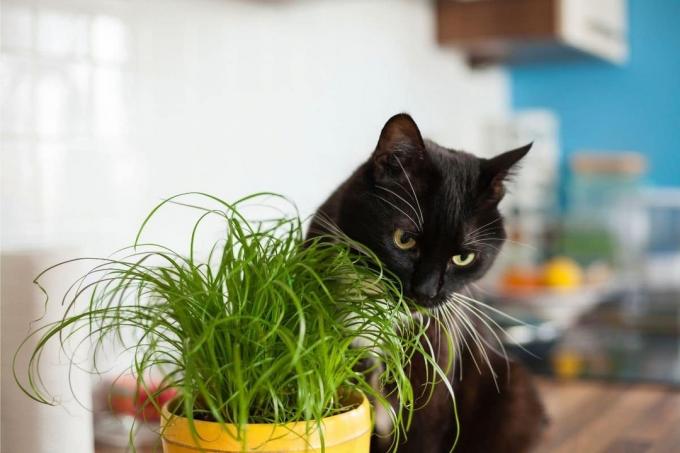
Note: So that the plants do not burn in spring, you need to slowly accustom them to sunshine. Slowly increase the number of hours of sunshine over a period of several weeks and permanently avoid the midday sun.
frequently asked Questions
In addition to their diet, cats need to consume grasses regularly to encourage the removal of indigestible hair from their stomach. That means, with enough cat grass, you make it easier for your velvet paws to choke up hairballs. This will prevent blockages. If your cats are outdoors, you don't have to worry about it as they are self-sufficient.
In addition to Cyperus zumula, various varieties of oats, wheat and rye are also offered. Due to their softer structure, they are better suited for cats that have a sensitive mouth and for whom the Cyprus grass is too hard. Seychelles grass (Pogonatherum paniceum) is another option. The maintenance measures do not differ.
The cats determine that by themselves. The animals instinctively eat as much cat grass as they need. Of course, your cat has to accept the grass in the first place. Not everyone is enthusiastic about the container plants and prefers the freely available grasses in the garden.
You can divide the growths. It is shared in spring. To do this, loosen the plants from the pot and separate the rhizomes from each other. Use a sharp and disinfected knife for this. Then put the pieces in a pot with a suitable substrate and care for the plants as usual.
Cat grass is robust and not prone to disease. Pest is the only problem. The plant most often struggles with spider mites when the cat grass is suffering from drought stress. In this case, either give the plant a thorough shower or spray. You can simply remove dead stalks. If the infestation has been contained, you must preventively ensure a permanently high level of humidity.



